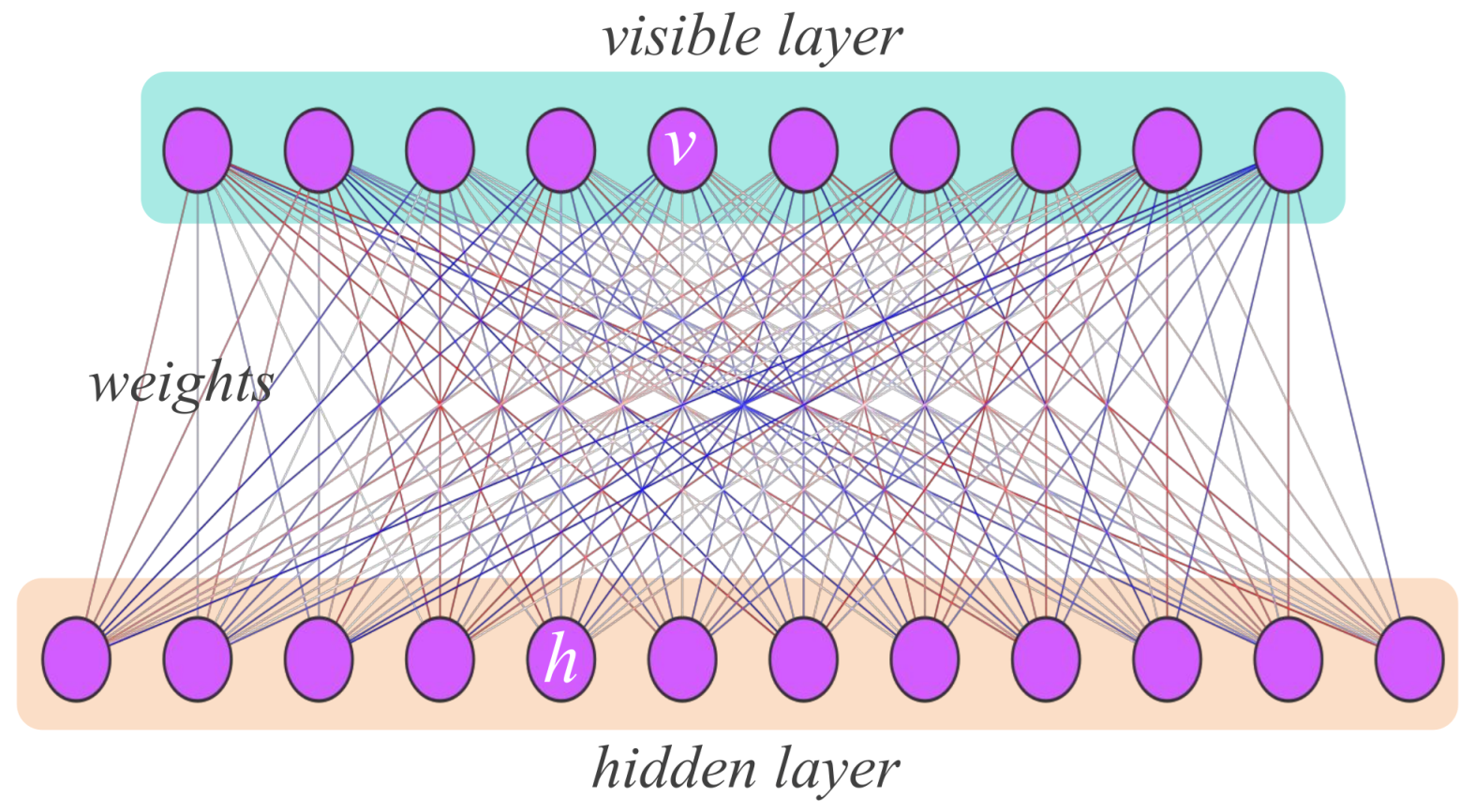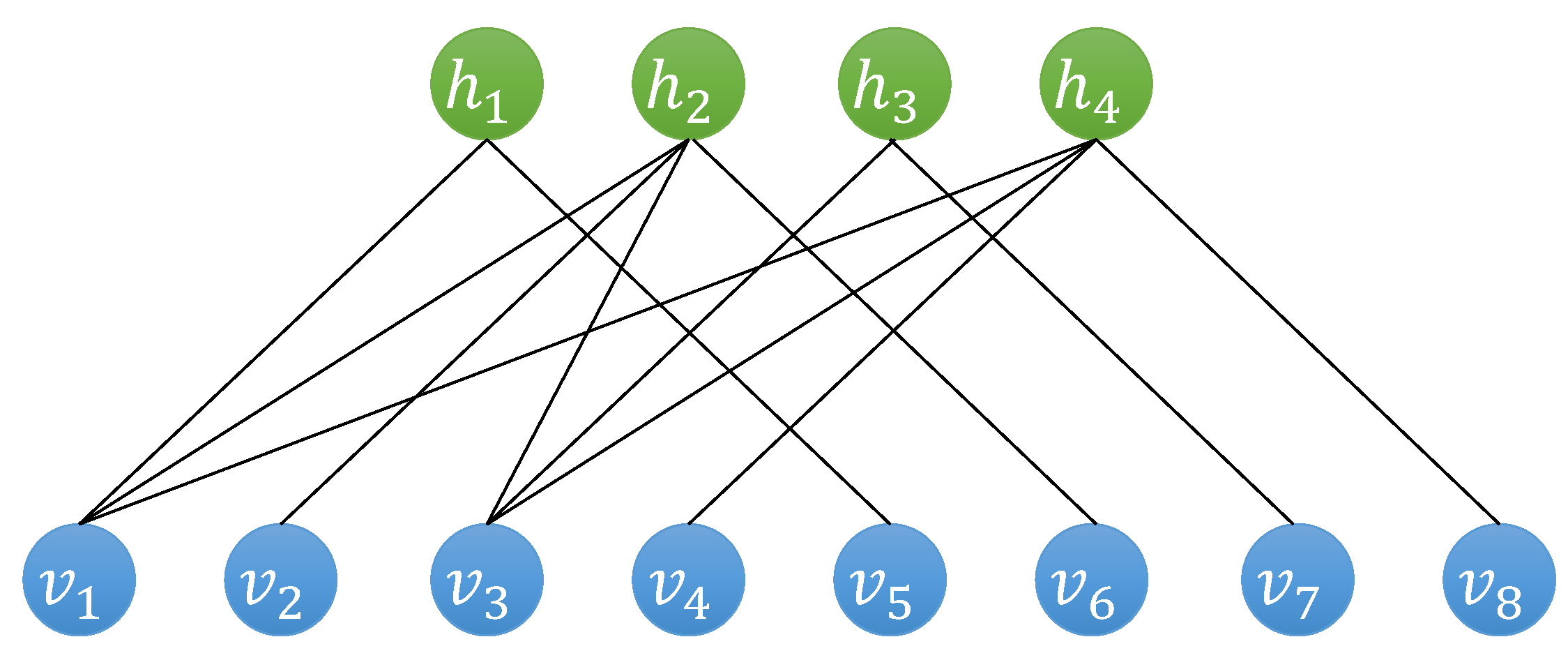An Efficient Algorithmic Way to Construct Boltzmann Machine Representations for Arbitrary Stabilizer Code
Abstract
1. Introduction
2. Preliminary Notions
- for all j, and .
- , for any .
3. Standard Form of Stabilizer Code



4. RBM Representation for an Arbitrary Stabilizer Group


- The identity block says that flips only qubit j;
- The matrix C tells us which qubits carry an extra Z in ;
- The matrix B flips the “×” qubits that are uniquely determined by the Z-type stabilizers. As stabilizers commute, the flips are consistent with the parity constraints, and we can ignore them for now;
- The zeros in the last r columns guarantee that none of the “×” qubits contributes any phase.
| Algorithm 1 Constructing RBM representation for the code state of the stabilizer group |
|
5. Conclusions and Discussions
- In this work, we presented the construction for stabilizer codes. However, its generalization to (or more generally, to finite groups [40,41,42] and to the (weak) Hopf algebra setting, see e.g., [43,44,45,46,47,48,49,50,51,52,53]) remains largely unexplored. Such a generalization is not only of interest for applications in quantum memory and error correction, but also plays an essential role in understanding quantum phases of matter described by local commuting projector Hamiltonians, where efficient descriptions of ground and excited states are highly desirable.
- The relationship between RBM representations and tensor network representations has attracted significant attention in recent years (see, e.g., [17,34]). It would be interesting to relate our results to existing approaches for representing quantum codes using tensor networks. Furthermore, exploring connections between RBM representations and other neural network architectures—such as convolutional neural networks, transformers, and others—is another promising direction for future research [25,26,27].
- Since the code state can be represented using an RBM, establishing RBM representations of quantum operations—such as measurements and quantum channels—would allow one to embed a quantum code fully within the RBM framework. This may offer new perspectives on leveraging machine learning techniques to assist with quantum error detection and correction.
Author Contributions
Funding
Data Availability Statement
Acknowledgments
Conflicts of Interest
References
- Osborne, T.J. Hamiltonian complexity. Rep. Prog. Phys. 2012, 75, 022001. [Google Scholar] [CrossRef] [PubMed]
- Verstraete, F. Quantum Hamiltonian complexity: Worth the wait. Nat. Phys. 2015, 11, 524. [Google Scholar] [CrossRef]
- Friesdorf, M.; Werner, A.H.; Brown, W.; Scholz, V.B.; Eisert, J. Many-Body Localization Implies that Eigenvectors are Matrix-Product States. Phys. Rev. Lett. 2015, 114, 170505. [Google Scholar] [CrossRef] [PubMed]
- Orús, R. A practical introduction to tensor networks: Matrix product states and projected entangled pair states. Ann. Phys. 2014, 349, 117–158. [Google Scholar] [CrossRef]
- Verstraete, F.; Murg, V.; Cirac, J. Matrix product states, projected entangled pair states, and variational renormalization group methods for quantum spin systems. Adv. Phys. 2008, 57, 143–224. [Google Scholar] [CrossRef]
- White, S.R. Density matrix formulation for quantum renormalization groups. Phys. Rev. Lett. 1992, 69, 2863–2866. [Google Scholar] [CrossRef]
- Verstraete, F.; Cirac, J.I. Renormalization algorithms for quantum-many body systems in two and higher dimensions. arXiv 2004, arXiv:cond-mat/0407066. [Google Scholar]
- Bañuls, M.C.; Hastings, M.B.; Verstraete, F.; Cirac, J.I. Matrix Product States for Dynamical Simulation of Infinite Chains. Phys. Rev. Lett. 2009, 102, 240603. [Google Scholar] [CrossRef]
- Vidal, G. Entanglement Renormalization. Phys. Rev. Lett. 2007, 99, 220405. [Google Scholar] [CrossRef]
- Vidal, G. Efficient Classical Simulation of Slightly Entangled Quantum Computations. Phys. Rev. Lett. 2003, 91, 147902. [Google Scholar] [CrossRef]
- Schuch, N.; Wolf, M.M.; Verstraete, F.; Cirac, J.I. Simulation of Quantum Many-Body Systems with Strings of Operators and Monte Carlo Tensor Contractions. Phys. Rev. Lett. 2008, 100, 040501. [Google Scholar] [CrossRef] [PubMed]
- Carleo, G.; Troyer, M. Solving the quantum many-body problem with artificial neural networks. Science 2017, 355, 602–606. [Google Scholar] [CrossRef] [PubMed]
- Deng, D.L.; Li, X.; Das Sarma, S. Quantum Entanglement in Neural Network States. Phys. Rev. X 2017, 7, 021021. [Google Scholar] [CrossRef]
- Gao, X.; Duan, L.M. Efficient representation of quantum many-body states with deep neural networks. Nat. Commun. 2017, 8, 662. [Google Scholar] [CrossRef]
- Jia, Z.A.; Wei, L.; Wu, Y.C.; Guo, G.C.; Guo, G.P. Entanglement area law for shallow and deep quantum neural network states. New J. Phys. 2020, 22, 053022. [Google Scholar] [CrossRef]
- Huang, Y.; Moore, J.E. Neural network representation of tensor network and chiral states. arXiv 2017, arXiv:1701.06246. [Google Scholar] [CrossRef]
- Chen, J.; Cheng, S.; Xie, H.; Wang, L.; Xiang, T. Equivalence of restricted Boltzmann machines and tensor network states. Phys. Rev. B 2018, 97, 085104. [Google Scholar] [CrossRef]
- Glasser, I.; Pancotti, N.; August, M.; Rodriguez, I.D.; Cirac, J.I. Neural-Network Quantum States, String-Bond States, and Chiral Topological States. Phys. Rev. X 2018, 8, 011006. [Google Scholar] [CrossRef]
- Liang, X.; Liu, W.Y.; Lin, P.Z.; Guo, G.C.; Zhang, Y.S.; He, L. Solving frustrated quantum many-particle models with convolutional neural networks. Phys. Rev. B 2018, 98, 104426. [Google Scholar] [CrossRef]
- Zhang, Y.H.; Di Ventra, M. Transformer quantum state: A multipurpose model for quantum many-body problems. Phys. Rev. B 2023, 107, 075147. [Google Scholar] [CrossRef]
- Wei, L.; Jia, Z.; Wang, Y.; Kaszlikowski, D.; Ling, H. Variational Transformer Ansatz for the Density Operator of Steady States in Dissipative Quantum Many-Body Systems. arXiv 2025, arXiv:2502.20723. [Google Scholar] [CrossRef]
- Torlai, G.; Melko, R.G. Latent Space Purification via Neural Density Operators. Phys. Rev. Lett. 2018, 120, 240503. [Google Scholar] [CrossRef] [PubMed]
- Hartmann, M.J.; Carleo, G. Neural-Network Approach to Dissipative Quantum Many-Body Dynamics. Phys. Rev. Lett. 2019, 122, 250502. [Google Scholar] [CrossRef] [PubMed]
- Nagy, A.; Savona, V. Variational Quantum Monte Carlo Method with a Neural-Network Ansatz for Open Quantum Systems. Phys. Rev. Lett. 2019, 122, 250501. [Google Scholar] [CrossRef]
- Carleo, G.; Cirac, I.; Cranmer, K.; Daudet, L.; Schuld, M.; Tishby, N.; Vogt-Maranto, L.; Zdeborová, L. Machine learning and the physical sciences. Rev. Mod. Phys. 2019, 91, 045002. [Google Scholar] [CrossRef]
- Jia, Z.A.; Yi, B.; Zhai, R.; Wu, Y.C.; Guo, G.C.; Guo, G.P. Quantum neural network states: A brief review of methods and applications. Adv. Quantum Technol. 2019, 2, 1800077. [Google Scholar] [CrossRef]
- Lange, H.; Van de Walle, A.; Abedinnia, A.; Bohrdt, A. From architectures to applications: A review of neural quantum states. Quantum Sci. Technol. 2024, 9, 040501. [Google Scholar] [CrossRef]
- Melko, R.G.; Carleo, G.; Carrasquilla, J.; Cirac, J.I. Restricted Boltzmann machines in quantum physics. Nat. Phys. 2019, 15, 887–892. [Google Scholar] [CrossRef]
- Le Roux, N.; Bengio, Y. Representational power of restricted Boltzmann machines and deep belief networks. Neural Comput. 2008, 20, 1631–1649. [Google Scholar] [CrossRef]
- Deng, D.L.; Li, X.; Das Sarma, S. Machine learning topological states. Phys. Rev. B 2017, 96, 195145. [Google Scholar] [CrossRef]
- Jia, Z.A.; Zhang, Y.H.; Wu, Y.C.; Kong, L.; Guo, G.C.; Guo, G.P. Efficient machine-learning representations of a surface code with boundaries, defects, domain walls, and twists. Phys. Rev. A 2019, 99, 012307. [Google Scholar] [CrossRef]
- Pei, M.Y.; Clark, S.R. Compact neural-network quantum state representations of jastrow and stabilizer states. J. Phys. Math. Theor. 2021, 54, 405304. [Google Scholar] [CrossRef]
- Chen, P.; Yan, B.; Cui, S.X. Representing arbitrary ground states of the toric code by a restricted Boltzmann machine. Phys. Rev. B 2025, 111, 045101. [Google Scholar] [CrossRef]
- Zheng, Y.; He, H.; Regnault, N.; Bernevig, B.A. Restricted Boltzmann machines and matrix product states of one-dimensional translationally invariant stabilizer codes. Phys. Rev. B 2019, 99, 155129. [Google Scholar] [CrossRef]
- Gottesman, D. Stabilizer Codes and Quantum Error Correction. Ph.D. Thesis, California Institute of Technology, Pasadena, CA, USA, 1997. [Google Scholar]
- Gottesman, D. Theory of fault-tolerant quantum computation. Phys. Rev. A 1998, 57, 127–137. [Google Scholar] [CrossRef]
- Nielsen, M.A.; Chuang, I.L. Quantum Computation and Quantum Information; Cambridge University Press: Cambridge, UK, 2010. [Google Scholar]
- Yan, J.; Bacon, D. The k-local Pauli Commuting Hamiltonians problem is in P. arXiv 2012, arXiv:1203.3906. [Google Scholar]
- Laflamme, R.; Miquel, C.; Paz, J.P.; Zurek, W.H. Perfect Quantum Error Correcting Code. Phys. Rev. Lett. 1996, 77, 198–201. [Google Scholar] [CrossRef]
- Kitaev, A. Fault-tolerant quantum computation by anyons. Ann. Phys. 2003, 303, 2–30. [Google Scholar] [CrossRef]
- Beigi, S.; Shor, P.W.; Whalen, D. The Quantum Double Model with Boundary: Condensations and Symmetries. Commun. Math. Phys. 2011, 306, 663–694. [Google Scholar] [CrossRef]
- Cong, I.; Cheng, M.; Wang, Z. Hamiltonian and Algebraic Theories of Gapped Boundaries in Topological Phases of Matter. Commun. Math. Phys. 2017, 355, 645–689. [Google Scholar] [CrossRef]
- Buerschaper, O.; Mombelli, J.M.; Christandl, M.; Aguado, M. A hierarchy of topological tensor network states. J. Math. Phys. 2013, 54, 012201. [Google Scholar] [CrossRef]
- Jia, Z.; Kaszlikowski, D.; Tan, S. Boundary and domain wall theories of 2d generalized quantum double model. J. High Energy Phys. 2023, 2023, 1–78. [Google Scholar] [CrossRef]
- Jia, Z.; Tan, S.; Kaszlikowski, D.; Chang, L. On Weak Hopf Symmetry and Weak Hopf Quantum Double Model. Commun. Math. Phys. 2023, 402, 3045–3107. [Google Scholar] [CrossRef]
- Jia, Z. Generalized cluster states from Hopf algebras: Non-invertible symmetry and Hopf tensor network representation. J. High Energy Phys. 2024, 2024, 147. [Google Scholar] [CrossRef]
- Jia, Z. Weak Hopf non-invertible symmetry-protected topological spin liquid and lattice realization of (1+1)D symmetry topological field theory. arXiv 2024, arXiv:2412.15336. [Google Scholar] [CrossRef]
- Jia, Z. Quantum Cluster State Model with Haagerup Fusion Category Symmetry. arXiv 2024, arXiv:2412.19657. [Google Scholar] [CrossRef]
- Yan, B.; Chen, P.; Cui, S. Ribbon operators in the generalized Kitaev quantum double model based on Hopf algebras. J. Phys. Math. Theor. 2022, 55, 185201. [Google Scholar] [CrossRef]
- Meusburger, C. Kitaev lattice models as a Hopf algebra gauge theory. Commun. Math. Phys. 2017, 353, 413–468. [Google Scholar] [CrossRef]
- Jia, Z.; Tan, S.; Kaszlikowski, D. Weak Hopf symmetry and tube algebra of the generalized multifusion string-net model. J. High Enegy Phys. 2024, 7, 207. [Google Scholar] [CrossRef]
- Jia, Z.; Kaszlikowski, D.; Tan, S. Electric-magnetic duality and Z2 symmetry enriched cyclic Abelian lattice gauge theory. J. Phys. Math. Theor. 2024, 57, 255203. [Google Scholar] [CrossRef]
- Chang, L. Kitaev models based on unitary quantum groupoids. J. Math. Phys. 2014, 55, 041703. [Google Scholar] [CrossRef]




Disclaimer/Publisher’s Note: The statements, opinions and data contained in all publications are solely those of the individual author(s) and contributor(s) and not of MDPI and/or the editor(s). MDPI and/or the editor(s) disclaim responsibility for any injury to people or property resulting from any ideas, methods, instructions or products referred to in the content. |
© 2025 by the authors. Licensee MDPI, Basel, Switzerland. This article is an open access article distributed under the terms and conditions of the Creative Commons Attribution (CC BY) license (https://creativecommons.org/licenses/by/4.0/).
Share and Cite
Zhang, Y.-H.; Jia, Z.; Wu, Y.-C.; Guo, G.-C. An Efficient Algorithmic Way to Construct Boltzmann Machine Representations for Arbitrary Stabilizer Code. Entropy 2025, 27, 627. https://doi.org/10.3390/e27060627
Zhang Y-H, Jia Z, Wu Y-C, Guo G-C. An Efficient Algorithmic Way to Construct Boltzmann Machine Representations for Arbitrary Stabilizer Code. Entropy. 2025; 27(6):627. https://doi.org/10.3390/e27060627
Chicago/Turabian StyleZhang, Yuan-Hang, Zhian Jia, Yu-Chun Wu, and Guang-Can Guo. 2025. "An Efficient Algorithmic Way to Construct Boltzmann Machine Representations for Arbitrary Stabilizer Code" Entropy 27, no. 6: 627. https://doi.org/10.3390/e27060627
APA StyleZhang, Y.-H., Jia, Z., Wu, Y.-C., & Guo, G.-C. (2025). An Efficient Algorithmic Way to Construct Boltzmann Machine Representations for Arbitrary Stabilizer Code. Entropy, 27(6), 627. https://doi.org/10.3390/e27060627





